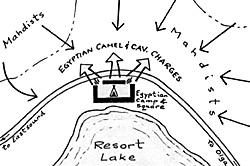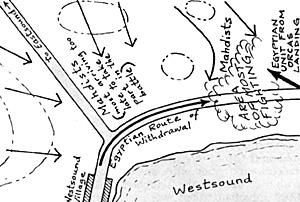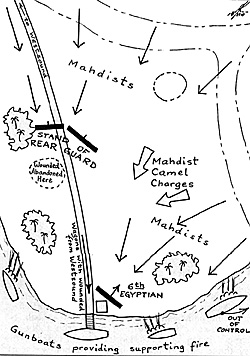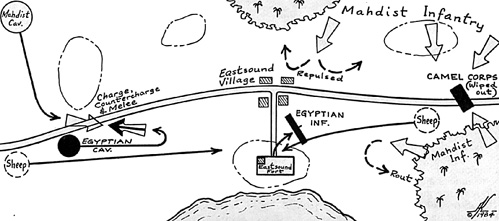The San Juan Islands, a recently conquered province of Egypt, have just gone into open revolt against the Khedive. The rebels are led by an Islamic fanatic who has proclaimed himself "the Mahdi", the "expected one". To date the rebellion has been limited to Orcas Island and has consisted of only refusals to pay taxes and a few raids against caravans and villages. In the last two days, however, all means of communications between Friday Harbor (the Provincial Capital) and Orcas Island have been cut off. The Governor-General, Akbar Pasha, was concerned that the revolt of the "False Prophet" had taken a turn for the worse.
On Orcas Island, the situation was far more serious than Akbar Pasha estimated. The eastern portion of the island had been in turmoil for about a week. No word had come from the military garrison at the village of Olga in four days. On the 13th of October (the day the telegraph line to Friday Harbor was cut).
Aboukir Bey, the military Governor of Orcas Island and commander of the garrison at Eastsound, sent a strong column out to meet the forces of the Mahdi. Manila Bey was sent out with all of Eastsound's mounted troops, one-third of the infantry and both field artillery batteries to advance towards the False Prophet's camp on the eastern portion of the island. Towards the end of the day, the column had halted to make camp on the north shore of Resort Lake. Cavalry piquets were not posted, and, before the dinner fires were hot, the Mahdists struck.
Referee's comments: This battle was fought using the IMPERIALISM rules. The outcome was pretty much determined in advance. The best I had hoped for was that the Egyptian commander could be able to retreat off the board with his mounted troops to warn the garrison at Eastsound. As you will soon read, even this did not come to pass.
The Mahdists, in overwhelming numbers, launched a highly disciplined attack on the Egyptian camp. Suicidal charges by the Egyptian Cavalry and Camel Corps allowed the infantry and artillery to form a square around the camp. Manila Bey's confidence in his defensive formation was shattered on only the second rush by the Mahdi's troops. The 4th Egyptians, holding the front face of the square, broke and threw the entire formation into a seething mass of humanity.
 Within 20 minutes the slaughter was
complete. Over 1,000 Egyptian troops were dead and two
artillery batteries (with nearly 500 rounds of ammunition)
and over 1,000 Remington Rifles with several hundred
thousand rounds of ammunition were now in the hands of
the Mahdists. Only 200 of the Mahdi's troops fell in
the battle of Resort Lake.
Within 20 minutes the slaughter was
complete. Over 1,000 Egyptian troops were dead and two
artillery batteries (with nearly 500 rounds of ammunition)
and over 1,000 Remington Rifles with several hundred
thousand rounds of ammunition were now in the hands of
the Mahdists. Only 200 of the Mahdi's troops fell in
the battle of Resort Lake.
The next morning saw Aboukir Bey standing on the ramparts of the fort at Eastsound and viewing the entire Mahdist throng surrounding his meagre garrison. Totally cut-off, he had no chance of fighting his way out. His only hope was to sit out the siege and await a relief column from Friday Harbor. There was a slim chance that the garrison at Westsound, under the command of Passamaquaddy Bey, would attempt to fight its way to Eastsound. Passamaquaddy Bey, however, had a better opinion of the situation and instead chose to abandon Westsound and Eastsound and evacuate the island via Orcas Landing (where he knew there was a flotilla of gunboats waiting to evacuate any survivors).
Referee's comments: In this battle, using THE SWORD AND THE FLAME, the Egyptians were given a list of possible courses of action. These options included holding the town, withdrawing to the west, withdrawing to the south, or (strange as it may seem) attempting a breakthrough to Eastsound. In all, six different objectives were numbered 1-6 and the Egyptian commander rolled a die in secret, so the Mahdist commander would not immediately know the Egyptian plan of action. The Mahdists were given two objectives, 1) capture the town, and 2) destroy the Egyptians.

The Mahdi, anxious to totally eliminate the presence of the "Turk" on Orcas Island, dispatched his able lieutenant, Abd al-Din to capture Westsound and destroy the Egyptian garrison there. The Egyptian withdrawal was just underway when the Mahdists appeared in the hills outside Westsound. A running battle ensued in which one of the three Mahdist "standards" succeeded in cutting off the Egyptian route of withdrawal. Passamaquaddy Bey had to fight his way through the blocking natives in order to continue his movement towards Orcas Landings. The Mahdists fought bravely, inflicting many casualties on the Egyptians. Eventually, the volleys from the Egyptians' Remington rifles broke the natives, and they fled. With the blocking natives eliminated, the Egyptians were able to continue their retreat to meet the gunboats (with Abd al-Din's men hot on their tails). The Egyptians lost about 100 men during the retreat from Westsound and the Mahdists suffered about 200 casualties.
Referee's comments: After looking at the battle of Westsound, one can easily see that both sides accomplished their objectives. Technically, the battle could be classed as a draw, but in an overall strategic view of the campaign, the Egyptians must be declared the losers as they were forced to withdraw, even though, had they stayed, they would have been wiped out!
Passamaquaddy Bey's withdrawal to Orcas Landing was no picnic. The Mahdists' continual harassment kept the column moving at a slow pace. With the dock in sight, the Egyptians turned to delay the native pursuers long enough for the wagons bearing the wounded from the previous battle to get to the Landing and load their passengers onto the waiting gunboats. The Mahdists, reinforced by cavalry and camelry were slow to engage the Egyptians. Several piecemeal attacks resulted in the virtual total elimination of the cavalry and the camels.
 The two companies of regulars covering the rear of the
wagons soon became bogged down holding off three units
of Ansar. Casualties quickly reached a point where the
units were utilizing most of their manpower to carry
wounded men towards the Landing. A stray bullet from
one of the Mahdists' recently acquired Remington rifles
dropped Passamaquaddy Bey as he attempted to steady
the rear guard. The loss of their gallant leader was too
much, and the survivors of the two companies dropped their wounded comrades and fled towards the gunboats.
The two companies of regulars covering the rear of the
wagons soon became bogged down holding off three units
of Ansar. Casualties quickly reached a point where the
units were utilizing most of their manpower to carry
wounded men towards the Landing. A stray bullet from
one of the Mahdists' recently acquired Remington rifles
dropped Passamaquaddy Bey as he attempted to steady
the rear guard. The loss of their gallant leader was too
much, and the survivors of the two companies dropped their wounded comrades and fled towards the gunboats.
The Mahdists, ignoring the abandoned wounded, pressed their attack on the lone remaining company of Egyptians guarding the dock at Orcas Landing. Supporting fire from the gunboat flotilla broke the Mahdist advances. One gunboat strayed too close to the shore and a volley of Mahdist gunfire killed the Captain and steersman, throwing the boat out of control and out of the action for four critical turns.
By dusk, the Mahdists were too weak to assault Orcas Landing, so they withdrew out of gun range, content to await for reinforcements to arrive during the night. The 6th Egyptians, though weakened from the fighting, forayed out at dusk and rescued about 25% of the wounded who had been abandoned on the battlefield before pressure from the Mahdists and the dimming light forced them to withdraw to the gunboats. Egyptian losses totalled nearly 200 of the 350 men engaged. The Mahdists lost over 500 men during the battle.
Referee's comments: in the battle of Orcas Landing, using the SWORD AND FLAME rules-including the gunboat rules outlined in THE HELIOGRAPH-we tried out Doug Johnson's ideas about "negative objectives". The Egyptians were given the objectives of
- 1) escorting the wagons bearing the wounded from
the previous battle to the gunboats, and
2) withdrawing their remaining troops from the island on the gunboats.
The only Mahdist objectives were to prevent the Egyptians from accomplishing their objectives. As can be seen, the Mahdists made a bad showing (partly due to bad movement cards) and the Egyptians were able to get away on the boats. Once again, however, the strategic victory must go to the Mahdists for they forced the Egyptians to abandon Orcas Island.
At Eastsound, things were getting desperate. Aboukir Bey found himself slowly running out of food while the Mahdi was content to sit and watch the Egyptians starve.
Finally, a call for volunteers went out in the fort ... volunteers to attempt a raid in the surrounding countryside for livestock. A mixed force of camel and horse mounted men was assembled and sent out to herd two flocks of sheep (one from the east and one from the west) back to the fort. Aboukir Bey had little hope that the foraging parties would ever be seen again, but the chance had to be taken if the garrison was to hold out much longer.
Referee's comments: This battle, again using the Yaquinto rules, combined two of Doug Johnson's ideas, the "raid" and the concept of "negative objectives. " The mounted forces had to get the sheep back to the fort. The safe arrival of both flocks would be a major victory, one flock would represent a minor victory. In both cases, the escorts were completely expendable.
For the Mahdists, who were off the table and rolled dice to determine the turn on which they entered in pursuit, had to merely prevent the sheep from reaching the fort.
 Luck seemed to be with the Egyptians. Both flocks
with their escorts were within sight of the fort before the
Mahdists reacted. In the east, the camel corps was hard-
pressed by ansar infantry. The fate of the flock was in
doubt for some time, though they finally made it through,
after the camel corps had been wiped out. A final threat to
the sheep was eliminated when Bash Shawish (Sgt.
Major) Salim shot down the leader of the last Mahdist
infantry unit, sending the ansar in flight.
Luck seemed to be with the Egyptians. Both flocks
with their escorts were within sight of the fort before the
Mahdists reacted. In the east, the camel corps was hard-
pressed by ansar infantry. The fate of the flock was in
doubt for some time, though they finally made it through,
after the camel corps had been wiped out. A final threat to
the sheep was eliminated when Bash Shawish (Sgt.
Major) Salim shot down the leader of the last Mahdist
infantry unit, sending the ansar in flight.
On the west side of the fort, the cavalry had little trouble in getting their sheep through. There was only one brief threat made by the late-arriving Mahdist cavalry, and that was eliminated by a charge and the subsequent melee. The Egyptians had outfoxed the Mahdists and there was plenty of food in the fort at Eastsound, at least for the time being.
Except for the besieged Aboukir Bey and the garrison at Eastsound, all Egyptian forces were now gone from Orcas Island. A major relief expedition, however, was being readied at Friday Harbor. Within a month, a force of nearly 2000 men (many of questionable value) would set sail from San Juan Island under the command of Twit Pasha. Their objective would be the relief of Westsound and the recapture of Orcas Island!
More San Juan Campaign:
- San Juan Campaign, Part I: Background
San Juan Campaign, Part I: Campaign Start
San Juan Campaign, Part II: Mahdist Mania
San Juan Campaign, Part III: Campaign Ends
The Sudan: Military History
-
The Sudan Part I: Introduction: The Mahdi
The Sudan: First British Involvement 1884-85
The Sudan: Anglo-Egyptian Sudan Map
The Sudan: Illustration: Troop Types of Hicks' Expedition (slow: 139K)
Sudan War Bibliography
Lynn Bodin: Bio of Theme Editor for Sudan
Whalers on the Nile: Sudan Transport Boats
Wargame Figures for the Sudan
Colonial Era Wargame Rules Overview
Sudan Part II: The Khalifa Takes Control, 1885
Sudan Part II: The Invasion of Egypt, 1889
Sudan Part II: The Dongala Expedition, 1896
Sudan Part II: Advance to Omdurman, 1897
Sudan Part II: Battle of Omdurman, 1898
Back to Table of Contents -- Courier Vol. V #4
To Courier List of Issues
To MagWeb Master Magazine List
© Copyright 1984 by The Courier Publishing Company.
This article appears in MagWeb (Magazine Web) on the Internet World Wide Web.
Other military history articles and gaming articles are available at http://www.magweb.com